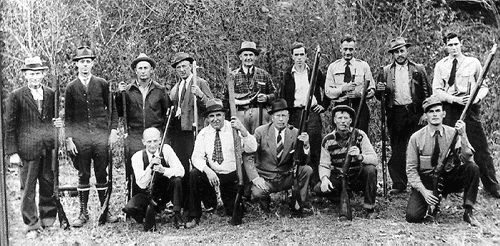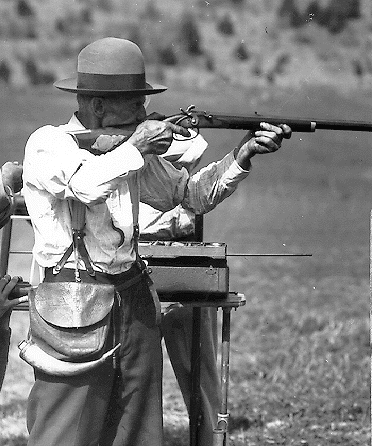|
Muzzle Blasts Online |
|
...for the muzzleloading enthusiast |
|
The muzzleblasts.com domain, subdomains, content, etc., are neither affiliated with the NMLRA nor its paper magazine Muzzle Blasts |
|
Muzzle Blasts Online |

|
|
|
|
|
|
A Heritage Preserved
Oscar L. Seth, president of the Norfolk & Western Railway YMCA Rifle and Revolver Club (and an avid smallbore shooter), told his friend and fellow-shooter, E.M. Farris, that he was tired of hearing hill-born railroaders boast that their uncles and grandpaps could knock out the eye of a squirrel at 50 paces with an old front-loader.
Farris, a collector of antique guns, was a man who combined his interest in firearms and shooting with a natural talent for promotion, to the ultimate benefit of the sport of muzzle loading.
The date chosen for the match was February 21, 1931. The course of fire was three shots prone with any kind of rest, and two shots offhand at 60 yards, using muzzle loading rifles with open metallic sights. Targets were NRA 50-yard bull's-eyes.
Interest in the match far exceeded the expectations of the planners. Sixty-seven shooters came from as far away as 125 miles, toting guns that had spent decades in gun rooms and attics. High score of the day was 37X50. If the shooting wasn't remarkable, the enthusiasm was, and it was decided to make the match an annual event.
By the time February 1932 rolled around, the contestants had learned a little about what it takes to make a muzzleloader shoot. Walter M. Cline, in The Muzzle Loader Then and Now, notes that there was a noticeable increase in accuracy among the shooters.
The following year, thirty-seven men, each contributing fifty cents, signed the roster of a new shooting organization for the purpose of holding national championships and promoting the sport of muzzle loading. Oscar Seth was elected president and Farris secretary-treasurer. The name, National Muzzle Loading Rifle Association, was officially adopted.
As it often happens with ideas whose time has come, the revival of old-time muzzle loading matches was not limited to the Portsmouth group. Boss Johnston, a homespun Hoosier philosopher broadcasting over WLW in Cincinnati, Ohio, and Powell Crosley, the owner of the station, put on a muzzle loading shoot in December of 1933. This match took place in the school yard grounds at Friendship, Indiana, within a mile of present-day NMLRA headquarters. It was such a success that plans were made for a match to be held the next year at Rising Sun, Indiana.
Among those attending the 1934 matches were Walter Cline, who had succeeded Seth as president of NMLRA, Farris and several others from the Portsmouth-based group. Farris and Cline met with Boss Johnston to discuss combining forces. Since the Portsmouth range was not large enough to accommodate the growing number of shooters, it was agreed to hold the 1935 National Matches at Rising Sun in conjunction with the Crosley Match.
The river served as a backstop, which required sounding a bell whenever a barge was approaching. "Hold your fire," was the order until the boat was safely by.
For the next several years, the shoots were held at Rising Sun and in the area around Dillsboro and Friendship. It became apparent that the NMLRA needed a home. The search for a permanent range culminated in the purchase of 54 acres just east of the village of Friendship. The tract, part of the Wilke Lemon farm, lay a beautiful valley deep in the hill country of southeastern Indiana. It was bisected by State Route 62 and the meandering Laughery Creek. Orville Jones and Boss Johnston laid out the original firing line in the fall of 1941 and the grounds were formally dedicated as the Walter Cline Muzzle Loading Rifle Range during the 1942 National Championships.
For the first few years, the range was not much more than an overgrown pasture, roughly mowed before each shoot. The old pin-framed, tobacco-curing barn was partially dismantled, moved to its present site and rebuilt to serve as a clubhouse. A small stone building was erected to provide rest rooms and tool storage. Shooters camped on the grounds or found lodging in private homes. It wasn't until 1958 that the first commercial row building was erected; until then, trading was carried out on tarps spread on the ground, makeshift tables, and car trunks.
Campfire gatherings are a tradition at all muzzle loading gatherings, and from the earliest years on the Walter Cline Range, it was around the campfires that stories were told, targets re-shot, friendships cemented, all to the cadence of banjo, fiddle, and guitar.
Many things have changed since the Laughery Valley became home to the NMLRA and the National Championships, but much remains the same. It is still "Mecca" to those who love the history and heritage of the old guns, and revere the ways of their ancestors. The hills still echo deep-throated booms as the sulphurous powder sends the ball toward its target. White smoke still drifts on the wind. And for those who know how to listen, voices long stilled murmur in the campfire's dying embers.

